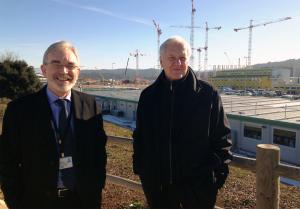Fritz Wagner: "The fusion community will be praised for its strategy"
It requires quite a bit of self-confidence to climb the stage in the ITER amphitheatre and face 200 employees of the world's largest fusion project with the question: Do we still need fusion?
But Friedrich "Fritz" Wagner had not come to southern France to tell ITER staff it was time to go home—on the contrary. Equipped with some very precise facts and figures, the German fusion scientist told the story of the current transformation from nuclear to renewable energies taking place in his home country. And who would know the maths behind the German Energiewende better than Wagner?
Having started his career in low-temperature physics he soon aimed for a warmer future in fusion research. In 1975 Wagner joined the Max Planck Institute for Plasma Physics (IPP) and became head of the ASDEX tokamak experiment in 1986. But it is not for his position that the name Fritz Wagner is known to every fusion student around the world—it is for his discovery of a high confinement regime called H-mode in 1982, a phenomenon "so much of our lives now depend on," as the head of ITER Plasma Operation, David Campbell, said in his introduction.
Wagner later joined the stellarator branch of the IPP as head of the Wendelstein 7-X project. Wagner holds the renowned Hannes Alfvén Prize from the European Physical Society (which he headed for many years). Today Fritz Wagner, although officially retired, tours the world as a prominent advocate for fusion. What was the major conclusion of his presentation to ITER? See below!
Mr Wagner, in your talk you sketched the essence of the German "Energiewende"—the transformation from a nuclear- and fossil-based energy market to a renewable energy market. From your observation, what is happening in Germany?
Germany has doubled its electricity producing power capacity by adding nearly 80 GW of wind and photovoltaic (PV) power. This process is driven by the fit-in-tariff system, a subsidy for renewable energy sources paid by the electricity consumer. Some of the consequences of this transformation are rather unexpected.
First, the operation of the thermal power stations (notably gas) becomes uneconomical and, instead, more lignite (low energy density coal) is burned—increasing, instead of decreasing, our CO2 emissions. German CO2 emissions have increased in parallel to the expansion of renewable energy sources. Another consequence is the rising price of electricity; German households pay (with Denmark) some of the highest prices today in Europe. The subsidy for renewable energy sources paid by the consumer reached EUR 24 billion in 2014. (In comparison, the spot market value of the electricity produced by renewables was only EUR 3 billion.)
Wind and photovoltaic are also intermittent sources. The national grids aren't complete enough to transfer the electricity produced in the north of the country through wind power, for example, to the south where it is needed. Electricity cannot be stored easily; meaning that on good days when surplus is produced, electricity is sold at negative prices. The economic viability of the Energiewende relies on large-scale storage, which is still in the research stage.
A final important consequence of the renewable energy strategy, in my mind, is the visual impact of wind farms on the northern landscape.
Will Germany one day be able to rely to 100 percent on renewables?
For the moment, we only produce a fraction of the energy we need from renewables. The answer long-term, again, hinges on storage. With large-capacity storage it is in theory, possible. But in practice, the numbers show that a backup system will always be needed to meet the load in periods of un-cooperating natural conditions. I think a realistic estimate would be relying on renewables for up to 40 percent of national demand.
A CO2-free energy supply is certainly something everybody wishes for, but can we afford this goal? Which implications would it have for the price of electricity?
Several countries in Europe produce electricity CO2-free at affordable prices—France, Switzerland, Sweden and Norway. They are already where others like Germany want to be in 2050. They use nuclear and benefit from hydroelectricity. To reach the same level of CO2 production during electricity generation, Germany would need 100 percent renewables and storage at large scale. This will make the electricity price high for Germans and will result in strong variation in electricity prices paid across Europe.
So, in conclusion, will we need fusion energy?
We have only four CO2-free options: renewable energy sources (wind and photovoltaic); fission with fast neutrons; carbon-capture and storage; and fusion. All four have pros and cons and are not completely developed. Research must be pursued vigorously in each option because research represents the only safety insurance we have. But with the predicted increase in world population by 2050, the supply situation becomes even more serious. I doubt that renewables will be able to exclusively provide the energy needed. I think fusion energy is an important supplement.
Who will make the race to the grid first? The stellarator or the tokamak?
Stellarators also rely on the success of ITER. It will not be possible to point to Wendelstein 7-X as another option in the case that ITER fails. Now, can a case still be made for the stellarators if ITER achieves Q=10 with bravado? Yes, if steady-state operation or disruptions pose a problem. If stellarators demonstrate good confinement, operate nicely for long pulses without impurity accumulation and density control issues, and—in addition—operate in the high-density H-mode regime of Wendelsteinn7-AS (the precursor to Wendelstein 7-X) then, yes, stellarators will have a good chance.
I expect that by 2030 the world energy problem will be so obvious to all that the fusion community will be praised for its twofold development strategy, and fusion scientists will be urged to continue developing both tokamaks and stellarators as quickly as possible.


